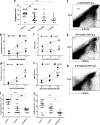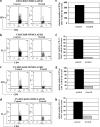An anti-inflammatory role of VEGFR2/Src kinase inhibitor in herpes simplex virus 1-induced immunopathology
- PMID: 21471229
- PMCID: PMC3126288
- DOI: 10.1128/JVI.00034-11
An anti-inflammatory role of VEGFR2/Src kinase inhibitor in herpes simplex virus 1-induced immunopathology
Abstract
Corneal neovascularization represents a key step in the blinding inflammatory stromal keratitis (SK) lesion caused by ocular infection with herpes simplex virus (HSV). In this report, we describe a novel approach for limiting the angiogenesis caused by HSV infection of the mouse eye. We show that topical or systemic administration of the Src kinase inhibitor (TG100572) that inhibits downstream molecules involved in the vascular endothelial growth factor (VEGF) signaling pathway resulted in markedly diminished levels of HSV-induced angiogenesis and significantly reduced the severity of SK lesions. Multiple mechanisms were involved in the inhibitory effects. These included blockade of IL-8/CXCL1 involved in inflammatory cells recruitment that are a source of VEGF, diminished cellular infiltration in the cornea, and reduced proliferation and migration of CD4(+) T cells into the corneas. As multiple angiogenic factors (VEGF and basic fibroblast growth factor [bFGF]) play a role in promoting angiogenesis during SK and since Src kinases are involved in signaling by many of them, the use of Src kinase inhibition represents a promising way of limiting the severity of SK lesions the most common cause of infectious blindness in the Western world.
Figures









Similar articles
-
Application of our understanding of pathogenesis of herpetic stromal keratitis for novel therapy.Microbes Infect. 2018 Oct-Nov;20(9-10):526-530. doi: 10.1016/j.micinf.2017.12.014. Epub 2018 Jan 9. Microbes Infect. 2018. PMID: 29329934 Free PMC article. Review.
-
Frontline Science: Aspirin-triggered resolvin D1 controls herpes simplex virus-induced corneal immunopathology.J Leukoc Biol. 2017 Nov;102(5):1159-1171. doi: 10.1189/jlb.3HI1216-511RR. Epub 2017 Jun 5. J Leukoc Biol. 2017. PMID: 28584076 Free PMC article.
-
Controlling herpes simplex virus-induced ocular inflammatory lesions with the lipid-derived mediator resolvin E1.J Immunol. 2011 Feb 1;186(3):1735-46. doi: 10.4049/jimmunol.1003456. Epub 2010 Dec 27. J Immunol. 2011. PMID: 21187448 Free PMC article.
-
Role of miR-132 in angiogenesis after ocular infection with herpes simplex virus.Am J Pathol. 2012 Aug;181(2):525-34. doi: 10.1016/j.ajpath.2012.04.014. Epub 2012 May 31. Am J Pathol. 2012. PMID: 22659469 Free PMC article.
-
Early events in HSV keratitis--setting the stage for a blinding disease.Microbes Infect. 2005 Apr;7(4):799-810. doi: 10.1016/j.micinf.2005.03.003. Epub 2005 Mar 22. Microbes Infect. 2005. PMID: 15857807 Review.
Cited by
-
Transcriptome Analysis Reveals Novel Entry Mechanisms and a Central Role of SRC in Host Defense during High Multiplicity Mycobacterial Infection.PLoS One. 2013 Jun 18;8(6):e65128. doi: 10.1371/journal.pone.0065128. Print 2013. PLoS One. 2013. PMID: 23824656 Free PMC article.
-
Potential Drugs Targeting Early Innate Immune Evasion of SARS-Coronavirus 2 via 2'-O-Methylation of Viral RNA.Viruses. 2020 May 10;12(5):525. doi: 10.3390/v12050525. Viruses. 2020. PMID: 32397643 Free PMC article.
-
Application of our understanding of pathogenesis of herpetic stromal keratitis for novel therapy.Microbes Infect. 2018 Oct-Nov;20(9-10):526-530. doi: 10.1016/j.micinf.2017.12.014. Epub 2018 Jan 9. Microbes Infect. 2018. PMID: 29329934 Free PMC article. Review.
-
Robo 4 Counteracts Angiogenesis in Herpetic Stromal Keratitis.PLoS One. 2015 Dec 31;10(12):e0141925. doi: 10.1371/journal.pone.0141925. eCollection 2015. PLoS One. 2015. PMID: 26720197 Free PMC article.
-
Host-Directed Antiviral Therapy.Clin Microbiol Rev. 2020 May 13;33(3):e00168-19. doi: 10.1128/CMR.00168-19. Print 2020 Jun 17. Clin Microbiol Rev. 2020. PMID: 32404434 Free PMC article. Review.
References
-
- Biswas P. S., Rouse B. T. 2005. Early events in HSV keratitis—setting the stage for a blinding disease. Microbes Infect. 7:799–810 - PubMed
-
- Bock F., et al. 2007. Bevacizumab as a potent inhibitor of inflammatory corneal angiogenesis and lymphangiogenesis. Invest. Ophthalmol. Vis. Sci. 48:2545–2552 - PubMed
Publication types
MeSH terms
Substances
Grants and funding
LinkOut - more resources
Full Text Sources
Research Materials
Miscellaneous

